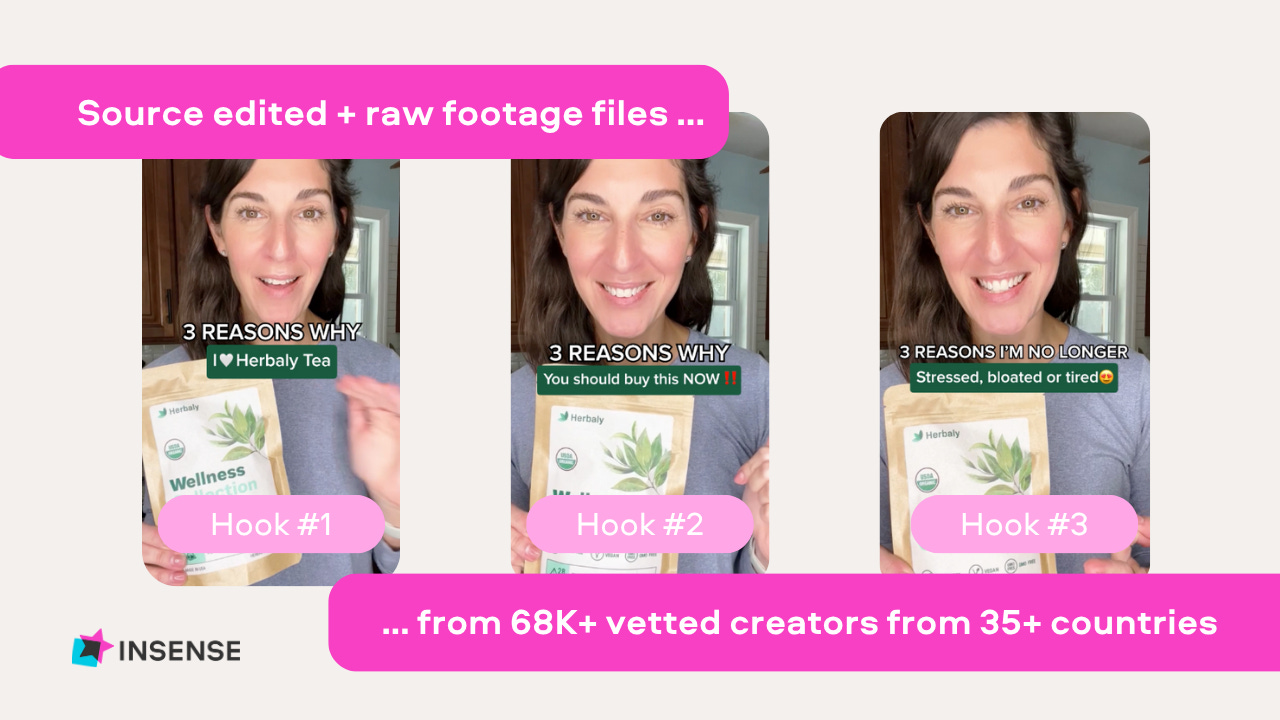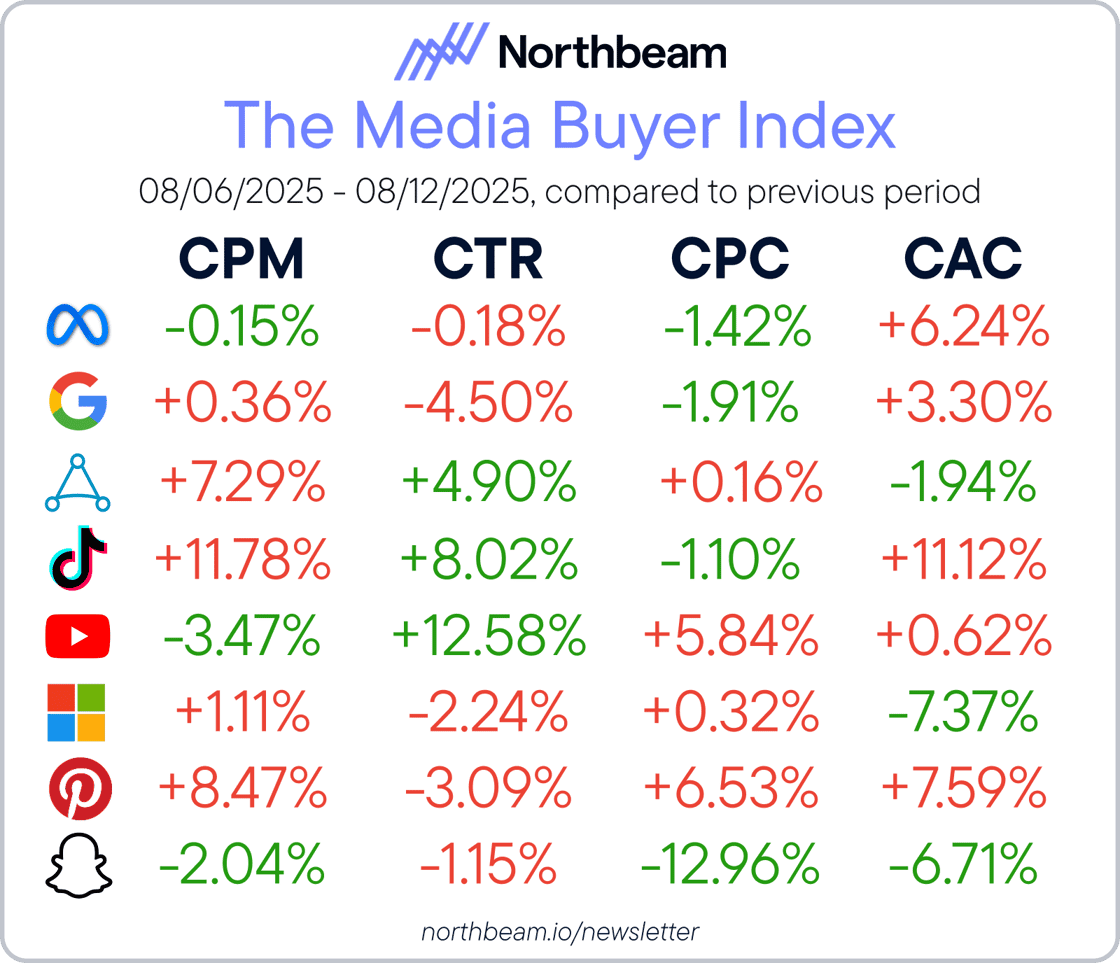The Overlooked CRO Multiplier
🎯 Turning interest into higher-margin orders, Northbeam reveals changing CPC CAC, and ROAS performance on major platforms and more!
Howdy Readers 🥰
In this newsletter, you’ll find:
🎯 Quantity Selector Design: The Overlooked CRO Multiplier
📊 Northbeam Media Buyer Index: CPC, CAC, and ROAS Insights (Aug 6–12)
🏆 Ad of the Day
If you’re new to ScaleUP then a hearty welcome to you, you’ve reached the right place along with 50k+ CEOs, CMOS, and marketers. Let’s get into it, shall we? Oh! Before you forget, if someone forwarded this newsletter to you, don't forget to subscribe to our newsletter so you never miss out!
Together with Insense
🚀 Creative Fatigue Is Killing Your ROAS. Here’s the Fix!
Every day a “winner” ad runs, it’s losing power. Click-through rates drop. Costs creep up. And while you wait for new creatives, competitors flood the feed with fresh content.
Insense gives you the edge.
One brief = 20+ ad-ready UGC assets from a single creator in under 14 days, all with lifetime usage rights, all for under $150 per creator.
Hooks, styles, CTAs, and formats, enough variety to test multiple angles at once, so you’re never betting the farm on one ad.
From Spark Ads to Meta Partnership Ads and influencer gifting, you’ll have high-quality UGC ready to drop straight into campaigns.
That’s how 2000+ brands like Solawave, Flo Health, and Nurture Life keep their performance curves climbing while others scramble to catch up.
Book your free strategy call by August 22 and get $200 toward your first campaign!
🎯 Quantity Selector Design: The Overlooked CRO Multiplier
Brands obsess over creative testing and PDP copy but leave quantity selectors as an afterthought. Yet, in dozens of CRO audits, selector design has produced 2–7% CVR lifts and $5–$15 AOV jumps without touching pricing or acquisition spend.
Why? Because it’s the first decision point after “yes, I’m interested.” And how that decision is structured can nudge customers toward higher-margin, higher-volume orders without them even realizing it.
1. Variant Layout Testing: Grid vs. Dropdown vs. Toggle vs. Stack
Public CRO data from Baymard Institute shows that dropdown selectors have the highest abandonment rate on mobile (due to extra taps), while toggle buttons and stacked grids see faster selections and ~8–12% higher upsell take rates. In a live test with a $60 AOV skincare brand, replacing a dropdown with a grid + visual SKU cues increased 3-pack purchases by 14%.
Key takeaway: Different layouts fit different cart contexts. For high-repeat consumables, grids outperform. For higher-AOV luxury, toggles with “Best Value” markers reduce choice overload.
2. Default Selection Psychology
Default bias is real; Nielsen Norman Group’s eye-tracking studies show that users spend over 40% less time scanning non-default options. In practice, this means pre-selecting a mid-tier bundle (rather than a single unit) can anchor perception and make premium packs feel like a better value.
Example: A specialty coffee brand pre-selected its 2-bag bundle, causing single-bag sales to drop from 55% to 38%, while total AOV rose 11% in 3 weeks.
3. Visual Anchoring for Profit Tiers
A study from Price Intelligently found that adding “Best Value” or “Most Popular” tags can increase selection of that option by up to 39%, provided it’s visually distinct (contrast color, border weight). High-performing brands like Gymshark and Bulletproof Coffee also pair this with price-per-unit breakdowns to reinforce the economic logic of higher-volume buys.
4. Scaling the System Across SKUs & Markets
A god-level CRO lever isn’t one that works once; it’s one you can deploy brand-wide.
Selector Systemization Framework:
Classify SKUs into “elastic” (easy to upsell) vs. “inelastic” (price-sensitive) categories.
Assign a default + highlight rule per category (e.g., mid-tier for elastic SKUs, single-unit for inelastic).
Test visual + layout changes regionally to account for cultural differences in choice behavior.
Audit performance quarterly, selector designs that win in Q1 can fatigue by Q4.
5. Failure Modes to Avoid
Mobile overload: Too many tiers or long labels cause scroll fatigue.
Margin leakage: Pre-selecting low-margin bundles for volume can harm profitability.
Mismatched logic: Inconsistent selector logic across SKUs confuses repeat buyers and erodes trust.
Bottom line: Quantity selector design is a silent AOV and CVR lever hiding in plain sight. Get it right, and it compounds across every paid channel. Get it wrong, and you’re paying for clicks that never convert at full value.
📊 Northbeam Media Buyer Index: CPC, CAC, and ROAS Insights (Aug 6–12)
The latest data shows mixed efficiency signals across major ad platforms, with some big-budget channels becoming cheaper to run while others get more expensive. CPC and CAC trends offer opportunities for scaling, while ROAS shifts highlight where to double down and where to optimize.
The Breakdown:
1 - CPCs Drop on Meta, Google, and Snapchat – CPC fell 1.42% on Meta, 1.91% on Google, and 12.96% on Snapchat, making clicks more affordable on high-spend platforms. This creates a prime window to expand prospecting and scale tests without inflating budgets, while rising costs on YouTube (+5.84%) and Pinterest (+6.53%) may pressure margins.
2 - CACs Improve on Meta, Google, and Microsoft – CAC dropped 6.24% on Meta, 3.30% on Google, and 7.37% on Microsoft, boosting acquisition efficiency across major ad channels. With TikTok (+11.12%), Pinterest (+7.59%), and Snap (+6.71%) seeing higher CACs, shifting spend toward the improving platforms could lock in lower costs before competition drives them up.
3 - ROAS Surges on Pinterest and Apple Search Ads – ROAS climbed 6.62% on Pinterest, 3.06% on Apple Search Ads, and 0.18% on Google, signaling stronger returns in those ecosystems. Reallocating budget toward these high-ROAS performers while troubleshooting low-return channels like YouTube (-8.26%) and TikTok (-7.66%) can protect efficiency and sustain growth.
Budget share remains concentrated on Meta (61.94%) and Google (27.13%), meaning even small efficiency gains here can drive big overall performance wins. Pinterest’s +27.52% budget share jump shows marketers are chasing returns fast, while Apple Search Ads’ -14.54% drop signals shifting attention away from smaller-share platforms.
Together with Tatari
Forward 2025: Where Top CEOs and Brands Unveil the Future of Advertising (Sept 4)
Customer acquisition is shifting fast – paid social is harder to navigate, TikTok faces uncertainty, and Gen Z is skipping Google for creators and AI. Forward 2025 is where ambitious brands learn what's next.
On September 4th at The Glasshouse in NYC, join this free half-day conference focused on the future of advertising.
Hear from Steve Huffman (Reddit CEO), Adam Foroughi (AppLovin CEO), and Allison Ellsworth (poppi Co‑Founder & CBO) – visionaries shaping how brands grow today.
Plus, marketing leaders from Dave, Coterie, Saatva, TickPick, Ariat, and Gusto will share exclusive TV growth playbooks across three dynamic panels.
Cap off the day with a rooftop happy hour overlooking the Hudson, connecting with speakers and peers.
Forward by Tatari is built for ambitious brands to scale smarter in a shifting ad world, with TV as the next big growth channel.
Seats are limited. Reserve your invitation and join industry leaders shaping the future of advertising.
🏆 Ad of the Day
What Works and Insights:
1 Headline mixing taste and health - The headline “Packed like a protein bar, tastes like cereal” works because it fuses function and indulgence in one quick hit, pulling in both health-conscious and taste-driven buyers. Swapping one half of the hook for a niche-specific trigger can sharpen its pull, for example, aligning it to gym-goers, busy parents, or office workers without losing the dual-benefit punch.
2 Fun, playful packaging design - The stat callouts,11g protein, 0g sugar, 100% vegan, sit exactly where the eye lands after reading the headline, locking in trust before the mind has time to wander. Changing the order of these benefits based on audience priority can push conversion higher, whether that’s leading with “0g sugar” for weight-watchers or “11g protein” for performance-focused buyers.
3 Social proof through customer numbers - Showing “18,000+ happy customers” works as a quick way to signal that the product is already popular and trusted by many. Turning this number into something more relatable, like highlighting how it’s grown over time, can make the proof feel stronger. It’s an easy way to reassure new buyers without adding extra complexity to the ad.
Broader Insights:
This ad shows how to mix health, fun, and trust in one design. It clearly states the benefits, uses playful branding to make it memorable, and adds proof that lots of people already love it. The message is clear: you can have a healthy snack that still feels like a treat.
Advertise with Us
Wanna put out your message in front of over 50,000 best marketers and decision makers?
We are concerned about everything DTC and its winning strategies. If you liked what you read, why not join the 50k+ marketers from 13k+ DTC brands who have already subscribed? Just follow this.
At ScaleUP, we care about our readers and want to provide the best possible experience. That's why we always look for ways to improve our content and connect with our audience. If you'd like to stay in touch, be sure to follow us EVERYWHERE🥰
Thanks for your support :) We'll be back again with more such content 🥳





